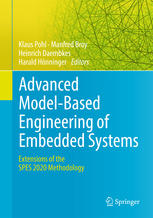

Most ebook files are in PDF format, so you can easily read them using various software such as Foxit Reader or directly on the Google Chrome browser.
Some ebook files are released by publishers in other formats such as .awz, .mobi, .epub, .fb2, etc. You may need to install specific software to read these formats on mobile/PC, such as Calibre.
Please read the tutorial at this link: https://ebookbell.com/faq
We offer FREE conversion to the popular formats you request; however, this may take some time. Therefore, right after payment, please email us, and we will try to provide the service as quickly as possible.
For some exceptional file formats or broken links (if any), please refrain from opening any disputes. Instead, email us first, and we will try to assist within a maximum of 6 hours.
EbookBell Team

4.3
68 reviewsThis book provides a comprehensive introduction into the SPES XT modeling framework. Moreover, it shows the applicability of the framework for the development of embedded systems in different industry domains and reports on the lessons learned. It also describes how the SPES XT modeling framework can be tailored to meet domain and project-specific needs.
The book is structured into four parts:
Part I “Starting Situation” discusses the status quo of the development of embedded systems with specific focus on model-based engineering and summarizes key challenges emerging from industrial practice.
Part II “Modeling Theory” introduces the SPES XT modeling framework and explains the core underlying principles.
Part III “Application of the SPES XT Framework” describes the application of the SPES XT modeling framework and how it addresses major industrial challenges.
Part IV “Evaluation and Technology Transfer” assess the impact of the SPES XT modeling framework and includes various exemplary applications from automation, automotive, and avionics.
Overall, the SPES XT modeling framework offers a seamless model-based engineering approach. It addresses core challenges faced during the engineering of embedded systems. Among others, it offers aligned and integrated techniques for the early validation of engineering artefacts (including requirements and functional and technical designs), the management of product variants and their variability, modular safety assurance and deployment of embedded software.